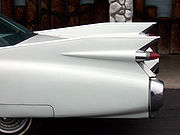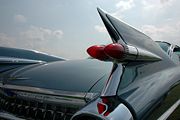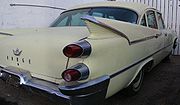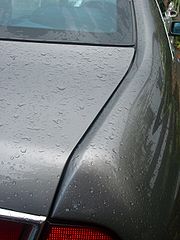
Tailfin
Encyclopedia






Automobile
An automobile, autocar, motor car or car is a wheeled motor vehicle used for transporting passengers, which also carries its own engine or motor...
styling encompassed the 1950s and 1960s, peaking between 1957 and 1960. It was a style that spread worldwide, as car designers picked up styling trends from the US automobile industry where it was the golden epoch of American autodesign.
General Motors design chief Harley Earl
Harley Earl
Harley J. Earl was first Vice President of Design at General Motors. He was an industrial designer and a pioneer of modern transportation design. A coachbuilder by trade, Earl pioneered the use of freeform sketching and hand sculpted clay models as design techniques...
is generally credited for the automobile tailfin, introducing small fins on the 1948 Cadillac. Harley credited the look of World War II
World War II
World War II, or the Second World War , was a global conflict lasting from 1939 to 1945, involving most of the world's nations—including all of the great powers—eventually forming two opposing military alliances: the Allies and the Axis...
fighter aircraft
Fighter aircraft
A fighter aircraft is a military aircraft designed primarily for air-to-air combat with other aircraft, as opposed to a bomber, which is designed primarily to attack ground targets...
for his inspiration, particularly the twin-tailed P-38 Lightning
P-38 Lightning
The Lockheed P-38 Lightning was a World War II American fighter aircraft built by Lockheed. Developed to a United States Army Air Corps requirement, the P-38 had distinctive twin booms and a single, central nacelle containing the cockpit and armament...
. As jet-powered aircraft, rockets, and space flight entered into public recognition, the automotive tailfin assemblies (including tail lights) were designed to resemble more and more the tailfin and engine sections of contemporary jet fighters and space rockets.
Plymouth
Plymouth (automobile)
Plymouth was a marque of automobile based in the United States, produced by the Chrysler Corporation and its successor DaimlerChrysler.-Origins:...
claimed that the Tailfins were not Fins, but "stabilizers" to place the "center of pressure" as far to the rear as possible and thus "reduce by 20% the needs for steering correction in a cross wind".
Some sub-models of the 1937 Cadillac Fleetwood
Cadillac Fleetwood
Lawrence P. Fisher was the Fisher brother most closely involved with Cadillac in its early years. In 1916 he joined the Fisher Body Company which had been formed by two of his brothers in 1908. Larry was one of four of the seven Fisher brothers who brought Fisher Body Corporation under the General...
, which predates the P-38, also contained hints of tailfins via projecting tail-light "paddles", although it is unclear if this influenced later fin designs. http://www.100megsfree4.com/cadillac/cad1940/cad48s.htm The 1941 Cadillac Series 63 4-Door Sedan also had a form of jutting tail-lights, although milder than the 1937 Fleetwood. Even though the 1948 model was the first conscious effort at fins, the earlier partial occurrences may have made the concept more acceptable to consumers and designers. (World War II
World War II
World War II, or the Second World War , was a global conflict lasting from 1939 to 1945, involving most of the world's nations—including all of the great powers—eventually forming two opposing military alliances: the Allies and the Axis...
produced a gap of Cadillac model production between the early 40s and late 40s as factories turned to military goods production, interrupting the development of the fin concept.)
The Cadillac 1948 fin styling proved popular and its use spread to other models in the General Motors family of brands. Soon it was adopted by other manufacturers; Chrysler's Virgil Exner
Virgil Exner
Virgil Max "Ex" Exner, Sr. was an automobile designer for numerous American companies, notably Chrysler and Studebaker. He is known for his "Forward Look" design on the 1955-1963 Chrysler products and his fondness of fins on cars for both aesthetic and aerodynamic reasons.-Early life:Born in Ann...
in particular took the tailfin idea on board. As confidence grew in the styling trend, the fins grew larger and bolder.
The most extreme tailfins appeared in the late 1950s. The fins on the 1959 Cadillac Eldorado were the largest and most outrageous ever fitted on a production car. Those fins were too much for many customers, however, and the tailfins shrank after that point. Within a couple of years, tailfins had become much less prominent, and by the mid 1960s, they were gone on many models. Vestigial tailfins remained on American cars into the 1980s, with the sides of the quarter panels often being raised above the trunk lid and the corner sharp-edged, or at least raised. Cadillac was one of the last makers to phase raised edges out, with vertically-arranged tail-light assemblies as well, on all of their products (except the Allanté
Cadillac Allanté
The Allanté was Cadillac's first venture into the ultra-luxury roadster market. The vehicle was sold from 1987 until 1993, with roughly 21,000 models built over its 7-year production run...
) all the way to the early 1990s.
Mercedes used something similar to tailfins (nicknamed "Heckflosse" in German), but they claimed that these were not tailfins but "sight lines" (Peilstege) to make it easier to determine the corners of the vehicle. In 1997, Lancia introduced the Lancia Kappa Coupé
Lancia Kappa
The Lancia Kappa is an executive car produced by Italian automaker Lancia. It replaced the Thema as Lancia's flagship model in 1994 and was itself replaced by Lancia Thesis in 2001. It shared its platform with the Alfa Romeo 166 and was available as a saloon, estate or coupé...
with similar rear "sight line" augmentation.
In 2010, the Cadillac SRX styling incorporated the trademark vertical taillights sculpted into tiny tailfins projecting from the rear.
Tailfins and other automobile protuberances have been implicated in legal cases including the precedent-setting Hatch v. Ford (1958) and Kahn v. Chrysler (1963). In both of these cases, children were injured by sharp protrusions on parked cars.
Examples of Tailfin Styling:
- Buick LeSabreBuick LeSabre1959LeSabre and all other 1959 Buicks not only got new names, but all-new styling as well, adopting the new GM B- and C-body used on all of the corporation's full-sized cars...
, 1959–1963 - Cadillac EldoradoCadillac EldoradoThe 1953 Eldorado was a special-bodied, low-production convertible . It was the production version of the 1952 El Dorado "Golden Anniversary" concept car, and borrowed bumper bullets from the 1951 GM Le Sabre show car...
, 1948–1966 - Chaika GAZ-13, 1959–1981
- Chevrolet Bel AirChevrolet Bel AirThe Chevrolet Bel Air is a full-size automobile that was produced by the Chevrolet division of General Motors for the 1950–1975 model years. Hardtops in the Chevrolet Deluxe Styleline model range were designated with the Bel Air name from 1950–1952, but it was not a distinct series of its own until...
, 1957–1960 - Chevrolet ImpalaChevrolet ImpalaThe Chevrolet Impala is a full-size automobile built by the Chevrolet division of General Motors introduced for the 1958 model year. Deriving its name from the southern African antelope, Chevrolet's most expensive passenger model through 1965 had become the best-selling automobile in the United...
, 1958–1960 - Chrysler New YorkerChrysler New YorkerThe Chrysler New Yorker was a premium automobile built by the Chrysler Corporation from 1939–1996, serving for several years as the brand's flagship model. A model named the "New York Special" first appeared in the 1930s...
, 1956–1961 - Chrysler WindsorChrysler WindsorThe Chrysler Windsor was a full-sized car built by the Chrysler Corporation of Highland Park, Michigan from 1939 through to the 1960s. The final Chrysler Windsor as known to Americans was produced in 1961, but continued production in Canada until 1966...
, 1956–1960 - DeSoto FirefliteDeSoto Fireflite-Design:The DeSoto Fireflite was introduced in 1955 as De Soto’s flagship model. The car was wider and longer than previous DeSoto models and it came equipped with a V8 engine producing 255 hp and PowerFlite automatic transmission. The transmission was operated by a Flite-Control lever located on...
, 1956–1960 - Dodge LancerDodge LancerThe Dodge Lancer is a passenger car from the Dodge division of Chrysler Corporation. Dodge used the Lancer name on three different vehicles over the years.-1955–1959:...
, 1955–1959 - EdselEdselThe Edsel was an automobile manufactured by the Ford Motor Company during the 1958, 1959, and 1960 model years. The Edsel never gained popularity with contemporary American car buyers and sold poorly. Consequently, the Ford Motor Company lost millions of dollars on the Edsel's development,...
(all models), 1958–1960 - Fiat 2100, 1959–1961
- Ford ConsulFord ConsulThe Ford Consul is a car manufactured by Ford in Britain.Between 1951 and 1962 the Consul was the four-cylinder base model of the three-model Ford Zephyr range, comprising Consul, Zephyr and Zephyr Zodiac...
, 1951–1962 - Ford FairlaneFord Fairlane- Automobiles :* Ford Fairlane , a car manufactured by the Ford Motor Company between 1955 and 1970* Ford Fairlane , a car manufactured by the Ford Motor Company of Australia between 1959 and 2007- See also :...
, 1957–1963 - Ford GalaxieFord GalaxieThe Ford Galaxie was a full-size car built in the United States by the Ford Motor Company for model years 1959 through 1974. The name was used for the top models in Ford’s full-size range from 1959 until 1961, in a marketing attempt to appeal to the excitement surrounding the Space Race...
, 1959–1961 - Ford ThunderbirdFord ThunderbirdThe Thunderbird , is an automobile manufactured by the Ford Motor Company in the United States over eleven model generations from 1955 through 2005...
, 1957–1963 - Ford ZephyrFord ZephyrThe Ford Zephyr was a car manufactured by the Ford Motor Company in the United Kingdom. Between 1950 and 1972, it was sold as a more powerful six-cylinder saloon to complement the four-cylinder Ford Consul: from 1962 the Zephyr itself was offered in both four- and six-cylinder versions.The Zephyr...
, 1951–1966 - ImperialImperial (automobile)Imperial was the Chrysler Corporation's luxury automobile brand between 1955 and 1975, with a brief reappearance in 1981 to 1983.The Imperial name had been used since 1926, but was never a separate make, just the top-of-the-line Chrysler. In 1955, the company decided to spin it off as its own make...
, 1955–1961 - Lincoln CapriLincoln CapriThe Lincoln Capri was a full-size automobile sold by Ford's Lincoln luxury division. It was introduced for the 1952 model year and discontinued soon after the 1959 model year....
, 1955–1957 - Lincoln ContinentalLincoln ContinentalThe Lincoln Continental is an automobile which was produced by the Lincoln division of Ford Motor Company from 1939 to 1948 and again from 1956 to 2002...
, 1957–1963 - Mercedes-Benz Fintail
- Mercury CometMercury CometThe Mercury Comet is an automobile produced by the Mercury division of the Ford Motor Company from 1960–1969 and 1971-1977 — variously as either a compact or an intermediate car.The Comet was based on the compact Ford Falcon and later the Ford Maverick...
, 1960–1964 - Mercury MeteorMercury MeteorThe Mercury Meteor was an automobile model produced by the Lincoln Mercury division of the Ford Motor Company from 1961 to 1963. For 1961, the name was applied to low-end full-sized vehicles; for 1962 and 1963, the name was applied to Mercury's mid-sized sedans, in a marketing attempt to appeal to...
, 1961–1963 - Mercury MontereyMercury MontereyThe Monterey was introduced in 1950 as a high-end two-door coupe in the same vein as the Ford Crestliner, the Lincoln Lido coupe and the Lincoln Cosmopolitan Capri coupe. The reason was to offer a more luxurious coupe as the FoMoCo still not had any hard top. The Mercury line got a styling redesign...
, 1957–1964 - Morris MajorMorris MajorThe Morris Major and Austin Lancer are passenger car models produced by the British Motor Corporation of Australia between 1958 and 1964...
(Series II & Elite,) 1959 - 1964 - Moskvitch 402Moskvitch 402The Moskvitch 402 is a small family car manufactured by the former Soviet maker MZMA, first time introduced in 1956 as a second generation of the Moskvitch#Generations series...
- Moskvitch 407, 1956–1965 - Moskvitch 408Moskvitch 408The Moskvitch-408 series is a small family car produced by the Soviet car manufacturer MZMA/AZLK between 1964 and 1976....
- Moskvitch 412Moskvitch 412The Moskvitch 412 , also called 2140 in 1975 prior to discontinuation and 1500 SL outside USSR, is a small family car produced by Soviet manufacturer MZMA/AZLK from 1967 to 1976. It was also built as the Izh 412 by IZH in Izhevsk from 1967 to 1982 and replaced by the spun off Izh Comby series...
, 1964–1976 - Peugeot 404Peugeot 404The Peugeot 404 is a large family car produced by French automobile manufacturer Peugeot from 1960 to 1975, with the exception of the truck which was sold until 1988. It was also made under licence in various African countries until 1991 . It was also built in Argentina by Sevel.Designed by...
, 1960–1975 - Plymouth FuryPlymouth FuryThe Plymouth Fury is an automobile which was produced by the Plymouth division of the Chrysler Corporation from 1956 to 1978. The Fury was introduced as a premium-priced model designed to showcase the line, with the intent to draw consumers into showrooms....
, 1956–1960 - Vauxhall Cresta PAVauxhall CrestaThe Vauxhall Cresta is a British car first introduced in 1954 by Vauxhall Motors as an upmarket version of the Vauxhall Velox . When the Wyvern was replaced in 1957 the new larger car took the Cresta name...
, 1957–1962 - Volga GAZ-21GAZ-21The GAZ M21 Volga, the first car to carry the Volga name, was developed in the early 1950s. Volgas were built to last in the harsh climate and rough roads of the Soviet Union, with high ground clearance , rugged suspension, strong and forgiving engine, and rustproofing on a...
, 1956–1970 - ZIL-111ZIL-111After unsuccessful tests with the prototype ZIL-Moscow in 1956 the ZIL-111 was introduced from ZIL in 1959. The styling was inspired by the mid-1950s Packard, a United States automobile manufacturer...
, 1959–1962

